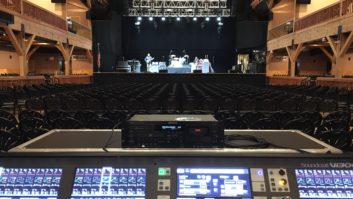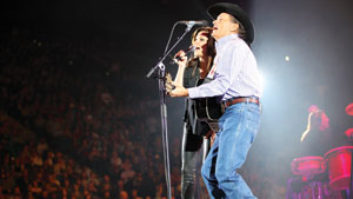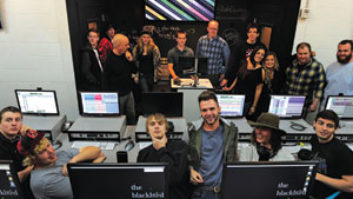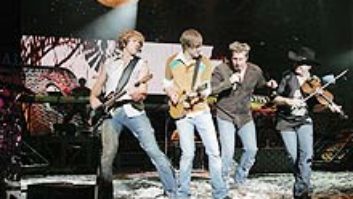Life on the road as a touring artist or an in-demand engineer can wreak havoc on one’s personal life — if that person gets to have one at all — for the sake of 200-plus touring dates a year. But country artist Martina McBride and her front-of-house engineer/husband, John McBride, have managed to balance rewarding careers with family life, and they extend that work/life balance to their loyal crew, which has become a family of its own after working together for many years.
During Martina McBride’s current arena tour, held in support of the recently released Waking Up Laughing, the stunning performer and mother of three makes sure to schedule no more than two weeks on the road in a row so that her crew and band don’t spend too much time away from their families. When it comes to her own children, she and John McBride often bring them along. “We’re very fortunate that we get to travel with our kids,” says John McBride. “We love having them out here. We’re not one of those couples that can leave the kids at home.” Heck, Martina McBride’s brother, Marty Schiff, has been playing acoustic guitar with the band for 15 years; he sings with his sister on “Trying to Find a Reason,” a duet she originally recorded with Keith Urban.
Of course, there are some drawbacks to working with your spouse. When John McBride assumes the FOH position, which he’s done for the artist for the past 15 years, he knows he must give his best effort every night, which is what they expect of everyone else. But with a career that includes forming one of Nashville’s most successful sound reinforcement companies, MD Systems, in 1980 (which merged with Clair Bros. in 1997); a lengthy stint as Garth Brooks’ production manager; and most recently, co-owner (with Martina McBride) of Nashville’s Blackbird Studio, there’s little danger of him mixing a lackluster show. The FOH engineer, monitor engineer Robert Bull, Clair Bros. systems tech Arpad Sayko and the rest of the audio team certainly lived up to their boss’ high standards when Martina McBride headlined the Oracle Arena in Oakland, Calif., where Mix caught up with the crew.
WORKING THE GIG
The audience that night obviously approved of what they heard as the vocalist led them through a streamlined set of old favorites, new hits and well-chosen covers. Her approachable demeanor and confident stage presence made even those in the upper balcony feel included (the large video screens helped) as they sang along to country radio standards such as “Independence Day” and “My Baby Loves Me,” as well as more recent hits such as “This One’s for the Girls” and her latest single, “How I Feel.” An A-list band — Greg Harrington, drums; Glen Snow, bass; Wayne Dahl, pedal steel; Jim Medlin, piano; Greg Foresman, electric guitar; Jennifer Wrinkle, fiddle and mandolin; and Schiff on acoustic guitar — backed the petite yet charismatic singer.
To power this premier ensemble, John McBride’s P.A. of choice remains the Clair Bros. i4 line array system. The system includes left and right arrays of 16 i4 loudspeakers each, with additional arrays of eight i3s each for sidefill. At the start of the tour, Clair Bros. also supplied i4B subs, which were flown next to the i4 arrays. “I opted to get rid of those subs and just use the low end that comes out of the P.A.,” the engineer explains. “I feel like it gives the most accurate sound for this type of show. We’re not a loud, hard-rock show, but we’re not a quiet show either; it’s pretty dynamic. There’s a lot of kick drum and a solid low end, but we don’t need 60 subwoofers to blur everyone’s vision. After spending so much time in the studio, I really like accuracy, which is hard to get in a large arena. But the i4 has been by far the best P.A. I’ve heard to get the job done.”
To compensate for the Oracle Arena’s boomy acoustics, an issue shared by many sports arenas doubling as concert venues, systems tech Sayko uses his ears, as well as the basic functions of Lake’s SmaartLive software installed on a tablet PC, to tune the room. Additionally, John McBride employs the Lake Contour digital speaker controller and its Contour Controller software for crossover management.
A self-professed “analog guy,” John McBride mixes on an ATI Paragon console using about 38 inputs from the stage. In conjunction with the ATI board, he uses API 500 Series mic pre’s on every input, some of them borrowed from his Nashville studio. “As good as the ATI mic pre’s sound, the APIs sound better,” he says. Considering the vast resources of gear available from Blackbird Studio (the studio’s mic list alone contains more than 800 vintage models), John McBride keeps his live setup relatively spartan.
He uses an SPL Transient Designer dynamics processor on drums, bass, piano and acoustic guitar; a BBE Sonic Maximizer on the kick and snare; and an innerTube Audio Atomic Squeezebox dual-analog compressor for Martina McBride’s vocals, which he pairs with an API pre and an ATI Pro 6 channel strip. Electric and upright bass and fiddle all run direct, while the Hammond B3 organ’s Leslie cabinet, the electric guitar and all vocalists (including the artist and four background singers) are miked with an assortment of Shure models. Martina McBride’s powerful pipes take a Shure UHF-R wireless with an SM58 capsule. “An SM58 with the right mic pre is a match made in heaven for her,” says John McBride. “I recommend it for any female vocalist to start out with.”
CONTINUING THE “FAMILY” TREE
Just as Martina McBride sings through a no-nonsense microphone, she also listens through standard Clair Bros. stage monitor wedges. “She doesn’t want all of the gadgetry,” says Bull, who joined the McBride “family” in 1997. “She just wants to be able to sing and go.” What she hears through the wedges varies from song to song — more standup bass on the traditional country numbers, more acoustic guitar and drums on other songs — but she’s always acutely aware of what she’s hearing and plays an active role in improving it.
“She knows her frequencies,” says Bull. “She knows what phase is, and she knows how she wants things to sound. We work really well together; sometimes we work through the whole show to get things right. Once, we worked until the very last song. During that song, she looked at me and gave me the thumbs up, like, ‘I knew you wouldn’t give up.’ It’s a team effort between her, myself and John. As a monitor engineer, it means a lot to know that the artist believes in you.”
With the exception of electric guitarist Foresman, who also uses wedges, the rest of the band listens through Shure wireless ear systems with Shure E5 earphones. Bull mixes on an ATI Paragon II, the first one to hit the road when ATI introduced the board in 1997. “It does everything I need it to do, immediately,” he says. Sharing John McBride’s preferences, Bull’s “monitor land” leans heavily toward analog gear, save for one digital reverb. He, too, keeps his toolbox pared down to the necessities. Most signals run from the mic through the ATI EQs and straight to the wedges. For musicians who use in-ears, he adds a Purple Audio MC76 FET limiter, “because when she’s really hammering down, her vocals won’t bury the mix.”
As with any successful musical collaboration, constant communication between artist, band and engineers ensures a quality show night after night, no matter how challenging the venue. And as the top female touring act this year for many weeks (falling second to Gwen Stefani) according to Pollstar, their hard work has certainly paid off. While talent also factors high into the equation, John McBride is quick to acknowledge the importance of teamwork and camaraderie. “We have a great crew, and attitude with me is 99 percent of the gig — always,” he says. “We have between 50 and 60 people out on the road with us, and for those that don’t have the right attitude it becomes apparent quickly, and we change that by finding somebody else that fits.”
During these summer jaunts, does John McBride ever get homesick for his studio and its vast contents of gear? “Not really,” he replies. As much as he loves collecting and using multitudes of ribbon mics and Fairchild compressors, “I love touring, I love the road,” he says. “There’s immediate gratification. You sing these songs, people clap, you go on to the next place. It’s unbelievable. In the studio, I’m working on a song that’s not going to see the light of day for nine months. That’s hard, but you’re also looking forward to the future because you know what’s coming out before anyone else does, and that’s great. I love the studio and I love the road. But the road pays better. [Laughs] So we do both, and it works out well.”
Heather Johnson is a San Francisco-based freelance writer.





